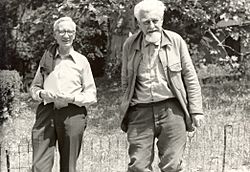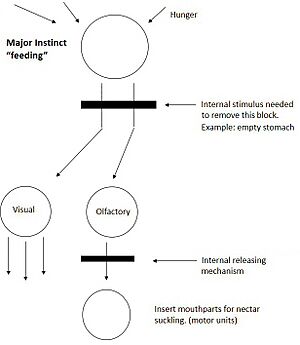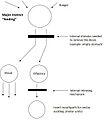Niko Tinbergen facts for kids
Quick facts for kids
Niko Tinbergen
|
|
|---|---|

Niko Tinbergen (left) and Konrad Lorenz (right)
|
|
| Born | 15 April 1907 |
| Died | 21 December 1988 (aged 81) |
| Nationality | Dutch |
| Alma mater | Leiden University |
| Known for | Hawk/goose effect Four questions |
| Awards | Nobel Prize in Physiology or Medicine (1973) |
| Scientific career | |
| Fields | Zoologist, ethologist |
| Institutions | Oxford University |
| Doctoral students | Richard Dawkins Aubrey Manning Desmond Morris |
Niko Tinbergen (born April 15, 1907 – died December 21, 1988) was a scientist from the Netherlands. He studied animal behavior, which is called ethology, and birds, which is called ornithology.
In 1973, he won the Nobel Prize in Physiology or Medicine. He shared this award with Karl von Frisch and Konrad Lorenz. They were recognized for their important discoveries about how animals behave. This included how they act alone and in groups, and what makes them do certain things.
In the 1960s, Niko helped make several wildlife movies. These included The Riddle of the Rook (1972) and Signals for Survival (1969). Signals for Survival won the Italia prize in 1969 and an American award in 1971.
Contents
About Niko Tinbergen's Life
Niko Tinbergen had two famous brothers, Luuk and Jan. During World War II, Niko was held captive. This experience caused some disagreements with his friend and fellow scientist, Konrad Lorenz. It took several years for them to become friends again.
After the war, Tinbergen moved to England. He became a teacher at the University of Oxford. He lived in England for the rest of his life. Many of his students at Oxford became important biologists. These include Richard Dawkins, Marian Dawkins, and Desmond Morris. Niko married Elisabeth Rutten, and they had five children.
Supernormal Stimuli in Animal Behavior
A big part of Tinbergen's research looked at what he called supernormal stimuli. This idea means that an artificial object can sometimes trigger an animal's instinct even more strongly than the natural object. This happens even if the instinct first developed for the natural object.
Experiments with Eggs
Tinbergen made plaster eggs to see which ones birds preferred to sit on. He found that birds would choose eggs that were larger. They also liked eggs with clearer markings or brighter colors. For example, a bright, polka-dotted egg would be chosen over the bird's own pale, spotted eggs. This showed that exaggerated features could strongly attract the birds.
Experiments with Fish and Butterflies
Tinbergen also found that male stickleback fish would attack a wooden fish model more fiercely than a real male fish. This happened if the model's underside was redder. He also made cardboard butterflies with very clear markings. Male butterflies would try to mate with these fake butterflies more than with real female butterflies. These superstimuli clearly showed what features were causing the animals' reactions.
Tinbergen's Four Questions
Niko Tinbergen is well known for creating four important questions. He believed these questions should be asked about any animal behavior to understand it fully.
Proximate Mechanisms: How Does it Happen?
These questions look at the immediate causes of behavior.
- 1. Causation: What are the triggers that make an animal respond? How has recent learning changed this response?
- 2. Development (Ontogeny): How does the behavior change as the animal gets older? What early experiences are needed for the animal to show this behavior?
Ultimate Mechanisms: Why Did it Evolve?
These questions look at the long-term reasons for behavior, like how it helps survival.
- 3. Evolution (Phylogeny): How does this behavior compare to similar behaviors in related species? How might this behavior have developed over time?
- 4. Function (Adaptation): How does the behavior affect the animal's chances of surviving and having offspring?
Research on Autism
Niko Tinbergen gave his Nobel Lecture about autism in children. He and his wife had been researching this topic for some time.
Images for kids
See also
 In Spanish: Nikolaas Tinbergen para niños
In Spanish: Nikolaas Tinbergen para niños




